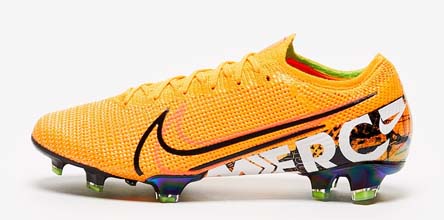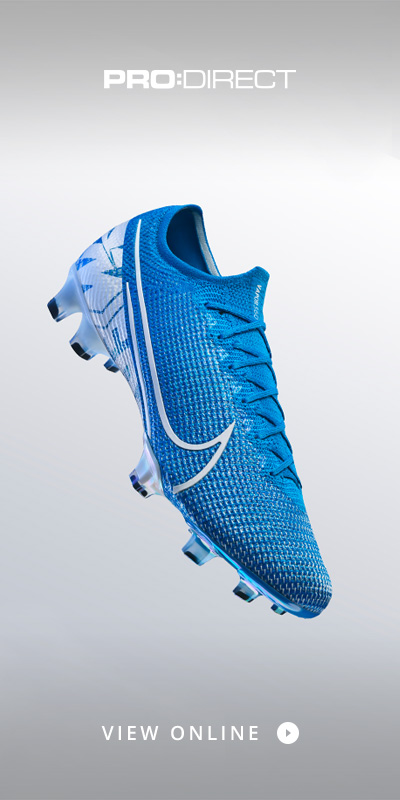The 2018 Mercurial 360 was heralded as a massive success by designers and pros alike, described by most players as the best Mercurial to date. It was overwhelmingly loved, and as such has already taken its place as one of Nike’s most beloved boots of all time. So where do you go from there? How do you improve on perfection?
That’s what we wanted to find out when we sat down with Senior Design Director, Jeongwoo Lee at the recent 2019 Mercurial launch event in Paris. The Nike veteran talked us through all the ideas and thought processes behind the updates, as well as the new accelerated design period that’s seen this next generation launched just 12 months after the last.
Firstly, can you just talk us through the quick turnaround for this latest Mercurial?
Sure, our new Mercurial is going to break rules to deliver a few firsts. It's already the first time that Nike have launched a product at a Women’s Word Cup, something that we feel super-proud of. And it's also the first time a product has been delivered in an accelerated time limit. Traditionally we work on a 24 month cadence, you probably remember 2014, then came 16, and then 18. Well it’s not 20 yet, but here we are launching a new Mercurial. The reason for that is just consumer driven. Consumers are expecting better, more often. Challenging, but we’re ready for the challenge.


How do you go about improving something as popular and successful as the 2018 Mercurial?
We focused on three areas for improvement. First was lockdown, and a yarn that pushes the boundaries of FlyKnit innovation to provide superior lockdown. At the same time, which is not easy, the stronger and better lockdown but with a softer touch. They kind of contradict each other. And third, lighter and faster, so we looked at the geometry of the plate, position of the studs to deliver yet more explosiveness for acceleration and deceleration. And of course, it’s not just about the technical side, it’s also about the emotional side, in this case when a player sees something they like they feel better, when they feel better they play better. So the style innovation component was important.
Orange has been such a prominent feature in the past for the Mercurial, so why did you take the decision to go blue for the launch colourway and what does it stand for?
When we did the early prototype, we did explorations in colour and we always do two things: we sample in white and different colours, from neon colours to white stripes. We do all sorts of testing and we look at what’s the most iconic colourway that actually pops from the green pitch, so that’s how we started with orange. But we want to surprise people, we don’t want the Mercurial to be just known for orange.
There are other neon colours that can be Mercurial. Blue is a colour that looked good, so we took the blue and added a bit of iridescent colouring and then some white pops so it feels like it’s a blue plus. So that was the idea. Even though the shoe is standing still on the shelf in the shops, because of the reflections it feels like it is moving. So that’s what we wanted to express.


There’s a lot of strong typography and also the return of that Nike Sportswear logo with the Swoosh and the Nike typeface. How much of an influence has there been from sneaker culture and what you see in trends off the pitch?
So even though this is a very high-performing football shoe, we wanted to tell the world that Mercurials are such an icon, and we wanted to connect both the sporting world with the lifestyle world. Today’s football players, like Mbappe or Ronaldo, when they’re on the pitch they’re all about being game-ready, but when they’re off the pitch they’re very much fashion stars, and we wanted to capture both aspects of that. Speed is a weapon that you have and it’s very cool as well. We wanted performance, style and expression all at the same time.
Traditionally, you’d spend about two years designing a boot, but trends off the pitch have never moved faster in the way they do. How hard is it to move quickly when you’ve spent two years in the making and then you think, actually, we need this trending…
The key is actually with the design. We don’t look at trends. We are aware of what’s happening, but we don’t really use anything. Instead everything we do here is rooted back to performance. Again, we know what the performance aspects are that we are going to go after and achieve, and how we visually showcase that for maximum effect. That’s the foundation of every style.
How does it feel now, looking back at the first ever Mercurial boot in comparison to where the boot finds itself now?
There is always that feeling of, I wish we could have done that better, looking back. As Nike say, there is no finish line, that’s kind of the approach that designers take. So we always stay obsessed. We are all feeling super-energised in the opportunity that we have to make the next best one after another. And as you heard before, we’re going to go hard on actually innovating faster, so not just every two years. Consumers they want things very quickly. They want Nike to be up there offering and surprising consumers, so we’re going to be innovating on a yearly basis.


What’s it like to be designing probably the most influential football boot on the planet?
To be honest, it’s super-fun, because it’s actually a dream project that every designer can think of. Not only is it a performance shoe, but you get to work with the likes of Neymar, Mbappe, Ronaldo, and at the same time it is a clinical expression of speed. Speed is one super power that every kid and every player wants to have, so as a designer to be able to show people and show the world that this is the speed machine for the foot, and make it better every year, that’s the dream job.
Pick up the Nike Mercurial Vapor XIII and Superfly VII at prodirectsoccer.com






























